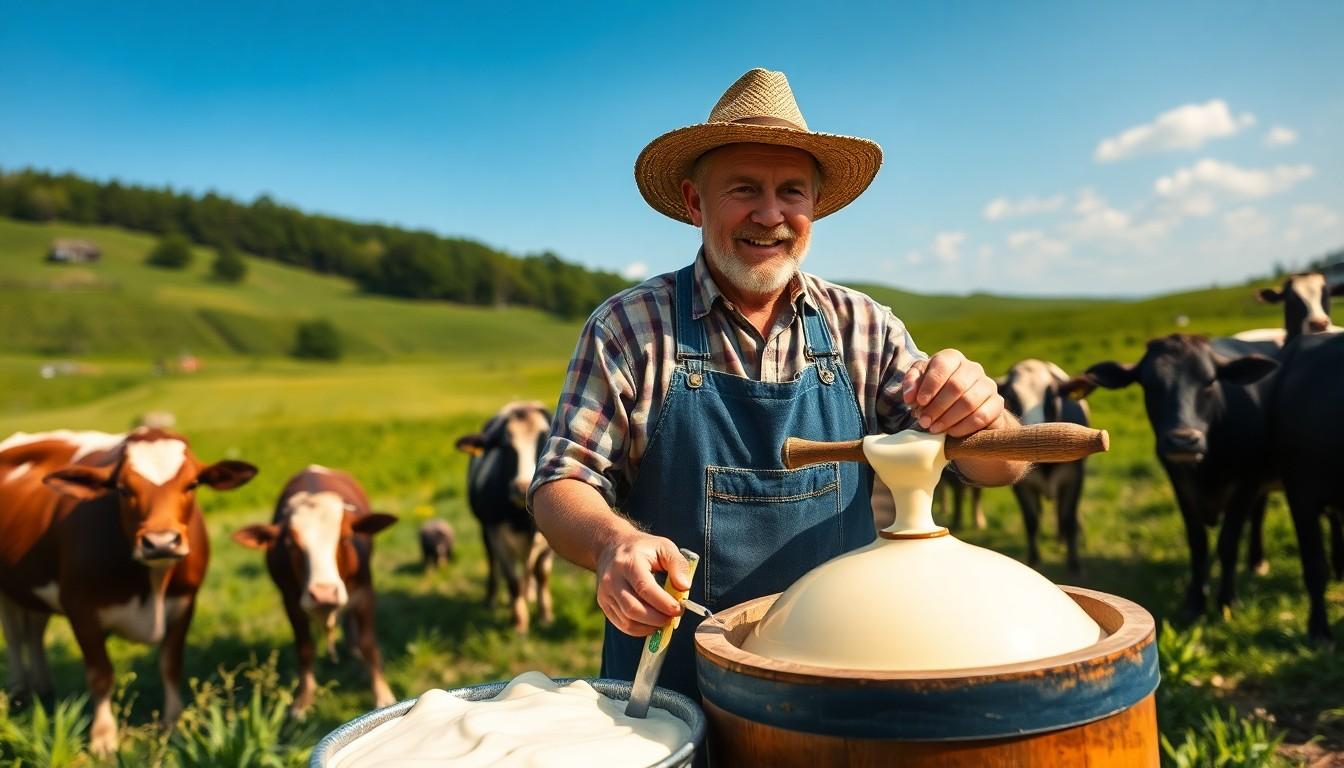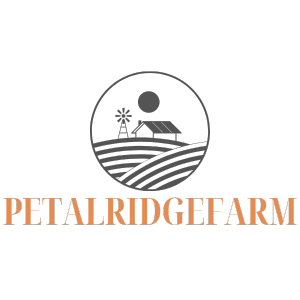In a world overflowing with margarine and impostor spreads, farmstead butter stands out like a golden beacon of deliciousness. Imagine slathering creamy, rich butter on warm, crusty bread straight from the farm. It’s not just butter; it’s a culinary experience that dances on your taste buds and whispers sweet nothings to your breakfast.
Farmstead Butter
Farmstead butter is a distinctive dairy product crafted on a farm from the milk of its own cows. This butter stands out due to its artisanal production methods, often involving small batches for greater quality control. Characteristics such as texture and flavor vary based on factors like breed of cow and feed.
Cream from fresh, unpasteurized milk is typically churned to produce this butter. Farmstead producers prioritize natural ingredients, avoiding artificial flavors and preservatives. Many consumers appreciate its rich, creamy flavor and clear divergence from mass-produced options.
Farmstead butter often contains higher butterfat content. The result is a luxurious mouthfeel that enhances any dish. Producers may offer it in various flavors, such as herbs, garlic, or even honey, for culinary versatility. Each flavor addition complements not just bread, but also vegetables, meats, and more.
Incorporating farmstead butter into cooking elevates simple recipes. Its unique qualities make it a favorite among chefs and home cooks alike. Increased awareness about sustainable practices drives demand for this product as well.
Farmstead butter represents the craftsmanship of local farmers and reflects a commitment to quality. Choosing this butter supports local economies and promotes traditional farming practices. These factors contribute to the growing market for farmstead butter nationwide.
The Process of Making Farmstead Butter

Making farmstead butter involves precise ingredients and traditional methods that enhance its rich flavor. The craftsmanship behind it reflects a commitment to quality.
Ingredients Used
Farmstead butter primarily uses fresh milk sourced from the farm’s cows. High butterfat milk contributes to its creamy texture. Natural flavorings such as herbs, sea salt, or fruit may enhance the butter’s taste. Each component directly influences the final product. Specific cow breeds, the quality of feed, and caring methods also impact the butter’s flavor profile. No artificial additives appear in true farmstead butter, ensuring a pure taste that stands apart from mass-produced options.
Traditional Methods
Traditional butter-making techniques emphasize small-batch processing. Churning milk into butter requires time and attention. Stone or wooden churns may be used, preserving the artisanal approach. Handcrafted methods ensure consistency while allowing for variations in texture and flavor. Some producers opt for cultured butter, letting natural bacteria develop a tangy taste. Techniques passed down through generations foster a connection to the land and its resources, ensuring sustainable practices in production.
Taste and Texture Profile
Farmstead butter offers a rich, creamy flavor that stands out, especially when spread on warm, crusty bread. Crafted on farms using the milk from local cows, it utilizes artisanal production methods that ensure exceptional quality. Variations in taste and texture arise from factors such as cow breed and feed, contributing to a unique culinary experience.
The higher butterfat content in farmstead butter results in a luxurious mouthfeel. Fresh, unpasteurized milk contributes to this distinctive creaminess while avoiding artificial additives. Some varieties showcase enhanced flavors through natural infusions, like herbs or sea salt, appealing to diverse palates.
Traditional butter-making techniques, including small batch processing, maintain consistency while simultaneously fostering unique variations in each batch. Cultured butter, a popular option among artisans, develops a tangy taste through natural fermentation, adding another layer of complexity. Chefs and home cooks alike appreciate its ability to elevate simple dishes, making it a versatile ingredient.
As consumer preference shifts towards sustainable practices, the demand for farmstead butter continues to grow. This choice supports local economies and traditional farming methods while reinforcing connections to the land. Farmstead butter not only serves as a culinary delight but also embodies a commitment to quality and sustainable agriculture.
Health Benefits of Farmstead Butter
Farmstead butter offers several health advantages that set it apart from conventional options. It contains higher levels of beneficial nutrients compared to margarine and imitation spreads. Nutritionally, it’s rich in vitamins A, D, E, and K2, which support overall health and wellness.
Consuming farmstead butter contributes to heart health. The milk fats in farmstead butter contain conjugated linoleic acid (CLA), which studies show may reduce heart disease risk. Such fats also support healthy cholesterol levels, promoting a balanced lipid profile.
It also contains butyrate, a short-chain fatty acid with anti-inflammatory properties. Studies indicate that butyrate supports gut health, improves digestive function, and may reduce inflammation in the body. A healthy gut contributes to better nutrient absorption and overall well-being.
Using farmstead butter in moderation can enhance satiety. The rich fatty acids in butter keep individuals feeling satisfied, which may help curb overeating. Chefs often utilize farmstead butter in recipes to elevate flavor and promote healthy eating habits.
Sourcing farmstead butter from local dairies bolsters community economies. This choice often means consuming dairy products from pasture-raised cows and sustainably managed farms. Such practices not only ensure quality but also promote animal welfare.
Farmstead butter also aligns with clean eating principles. It typically lacks preservatives and artificial ingredients found in processed butters, offering a more natural option. Incorporating this butter into daily meals provides nutritional benefits that align with a healthy diet.
Being rich in flavor, farmstead butter often enhances dishes without requiring excessive amounts. Its creamy texture can replace other fats in various recipes, resulting in healthier meals without sacrificing taste.
Farmstead Butter vs. Commercial Butter
Farmstead butter stands apart from commercial butter in several significant ways. It’s crafted on a farm using milk from its own cows, emphasizing a localized production approach. This contrasts with commercial butter, which typically sources milk from various suppliers, resulting in less distinctive flavors.
Artisan production methods define farmstead butter’s character. Traditional techniques, such as small-batch processing, create a rich texture and depth of flavor. Conversely, commercial butter often undergoes mass production processes, which may lead to a uniform taste and lower quality.
The flavor spectrum of farmstead butter varies greatly. Different cow breeds and diets contribute unique taste profiles, which differ from the often bland flavors found in commercial alternatives. As a result, farmstead butter offers culinary versatility and elevates dishes in ways that commercial butter may not.
Nutritional content is another area of distinction. Farmstead butter is rich in essential vitamins like A, D, E, and K2, along with beneficial fats that support heart health. Commercial butter, while still providing some nutrients, often lacks the high butterfat content and health benefits associated with its farmstead counterpart.
In terms of sustainability, farmstead butter gains attention for supporting local economies and traditional farming practices. Many consumers favor it due to its lack of preservatives and artificial ingredients. Meanwhile, commercial butter frequently contains additives for extended shelf life, which may not align with clean eating principles.
These differences highlight the growing consumer interest in high-quality, sustainable options. Farmstead butter not only enhances flavors but also supports healthy eating habits and local communities. The choice between the two often reflects personal values about food quality and sourcing.
Culinary Creations
Farmstead butter stands out as a flavorful and nutritious alternative to conventional options. Its artisanal production methods and commitment to quality resonate with consumers seeking authentic culinary experiences. By choosing farmstead butter, individuals not only enhance their meals but also support local economies and sustainable farming practices.
The rich taste and health benefits make it a versatile ingredient in both everyday cooking and gourmet dishes. As awareness of its advantages grows, farmstead butter is likely to continue gaining popularity among those who value quality, flavor, and a connection to the land. Embracing this delightful ingredient can transform simple dishes into extraordinary culinary creations.

